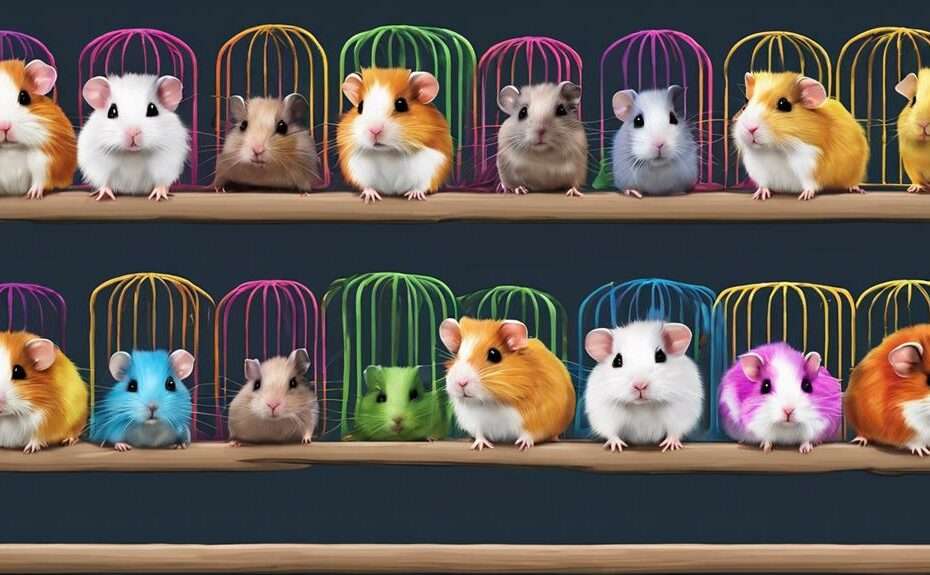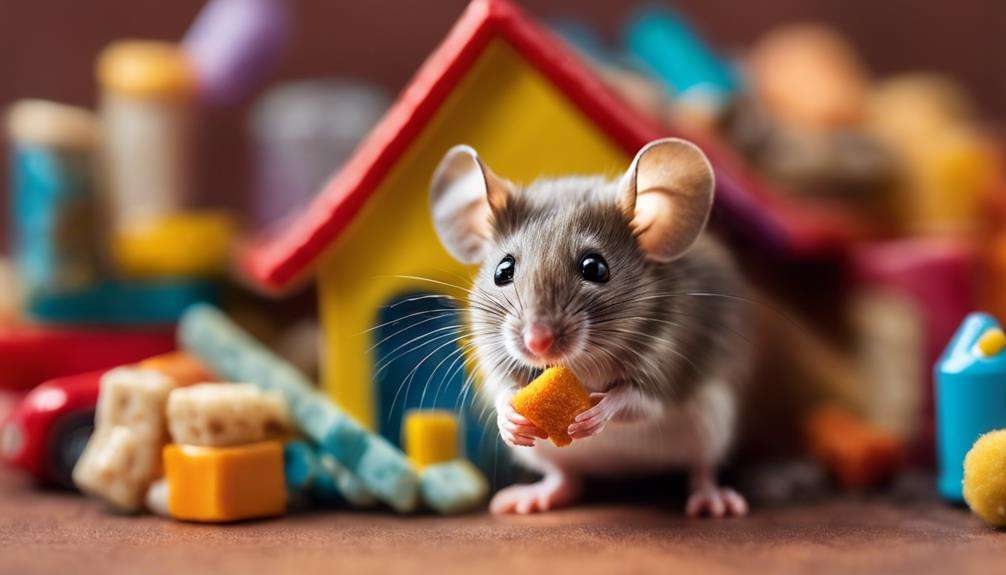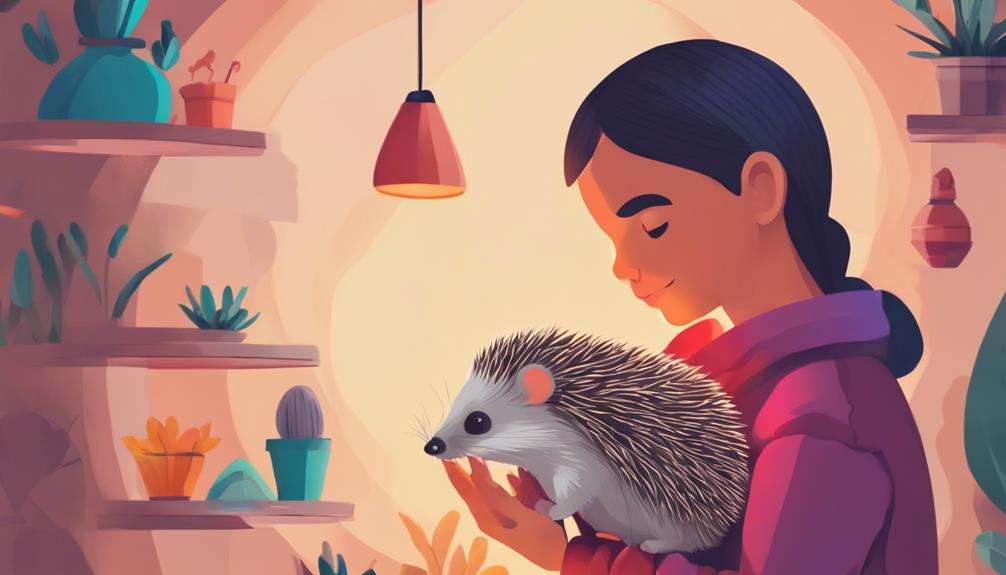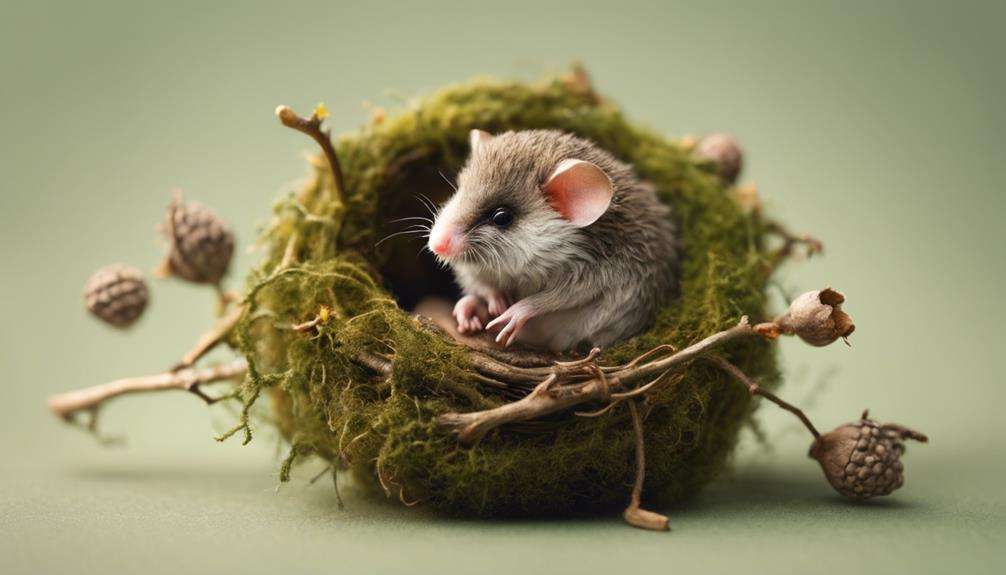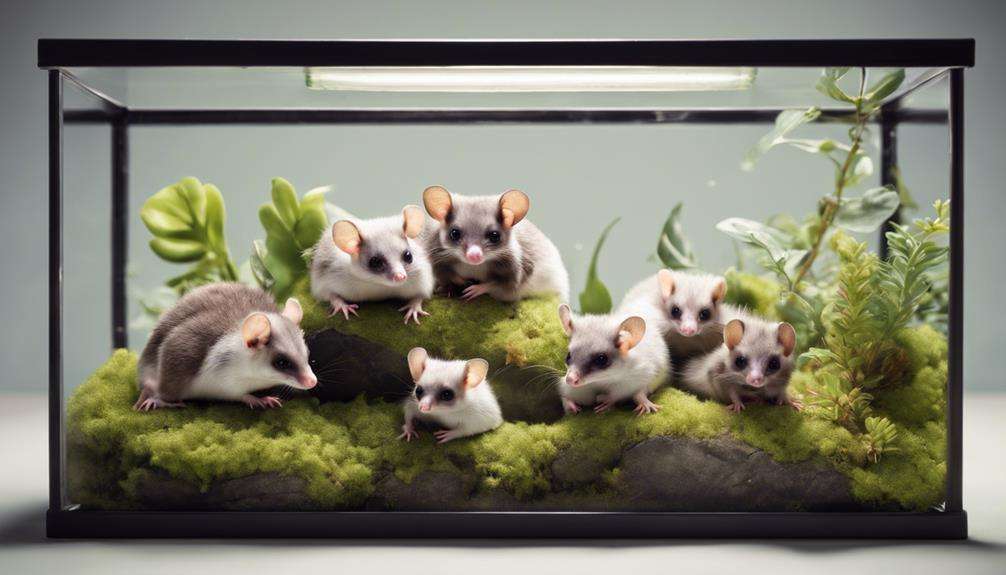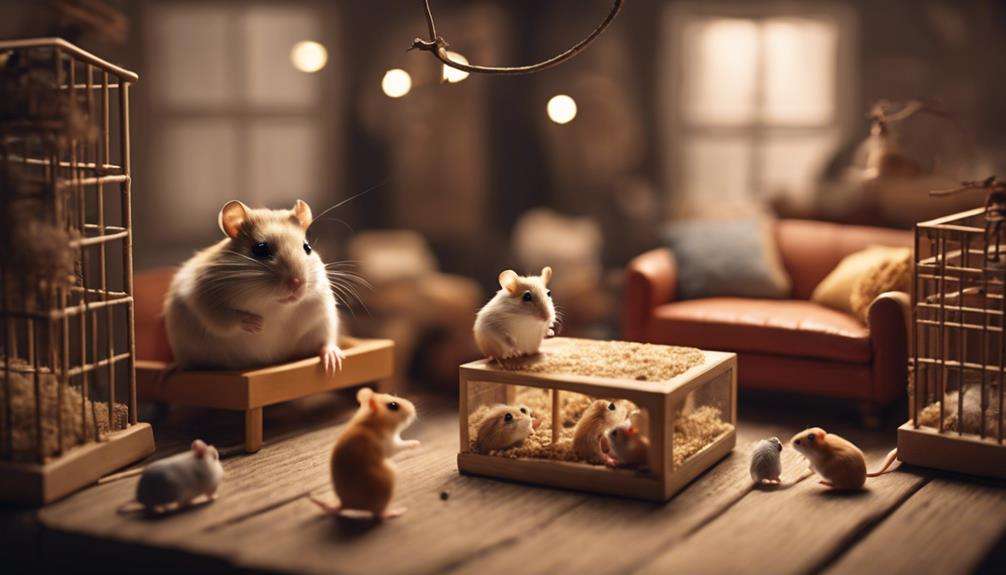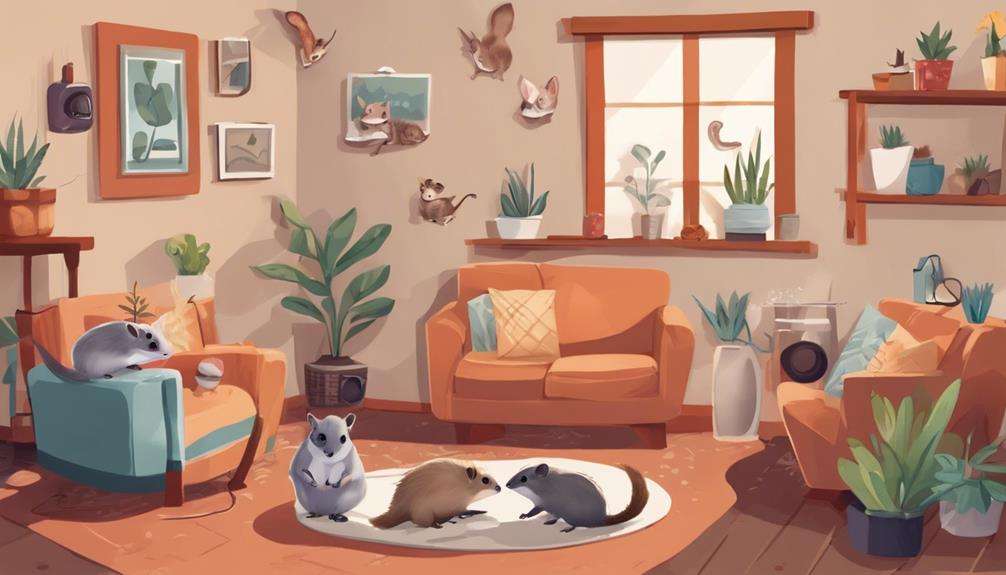If you've ever considered Pygmy Hedgehogs as potential furry companions, you'll be intrigued by the diverse range of pocket pets available for your consideration.
From the energetic Sugar Gliders to the charming Chinchillas and even the exotic Skunks, the world of furry pocket pets offers a fascinating array of options.
Each creature brings its own unique characteristics and care requirements, making the choice a thought-provoking journey into the domain of unconventional pet ownership.
Key Takeaways
- Pygmy Hedgehogs, Chinchillas, Sugar Gliders, and Skunks offer unique companionship with diverse care needs.
- Bonding, socialization, and mental stimulation are crucial for forming strong relationships with pocket pets.
- Attention to diet, grooming, and environment is essential for the longevity and well-being of furry pocket pets.
- Providing a variety of foods, dust baths, and interactive toys is key to ensuring the happiness and health of pocket pets.
Pygmy Hedgehogs
Native to Africa and Europe, pygmy hedgehogs are small, nocturnal mammals known for their unique defense mechanism of rolling into a tight ball when threatened. These small pets, also referred to as pocket pets due to their size, make fascinating companions for those willing to provide the necessary care. Pygmy hedgehogs are solitary creatures that require secure and spacious enclosures to thrive in captivity. When considering them as small animals to keep, it's essential to mimic their natural habitat as much as possible.
In the wild, pygmy hedgehogs have a varied diet that includes insects, fruits, and vegetables. To ensure their well-being in captivity, providing high-quality cat food formulated for their specific dietary needs is recommended. Regular handling and socialization are important for bonding with these adorable creatures. Despite their small size, pygmy hedgehogs have distinct personalities and can form strong bonds with their owners. It's important to approach their care with dedication and attentiveness to make sure they lead healthy and happy lives.
Sugar Gliders
Sugar gliders require a varied diet consisting of fruits, vegetables, insects, and specialized sugar glider food to make sure they receive adequate nutrition.
Bonding and socialization are vital for these small marsupials, as they form strong connections with their human companions and thrive in pairs or small groups.
Providing a large, multi-level cage with branches, ropes, and nesting areas is essential to mimic their arboreal habitat and support their natural behaviors.
Sugar Glider Care
Furry pocket pets known as sugar gliders require specialized care to thrive in captivity, including proper bonding and mental stimulation. Sugar gliders, with a potential lifespan of 10-15 years, are similar to Guinea Pigs in their need for companionship. Make sure to provide them with ample social interaction to prevent loneliness and stress.
Creating a strong bond with your sugar glider through gentle handling and spending time together is critical for their well-being. Additionally, these nocturnal creatures need plenty of mental stimulation in the form of toys, climbing structures, and opportunities to explore their environment.
Diet and Nutrition
To guarantee the peak health and well-being of sugar gliders in captivity, it's important to carefully consider their dietary requirements and nutritional needs. Sugar gliders, similar to guinea pigs, need a diverse diet that includes protein sources like insects, fruits, vegetables, and a specialized pellet diet.
Ensuring the correct balance of calcium and phosphorus ratios is essential for their bone health. Offering a variety of food items every day is key to preventing nutritional deficiencies and promoting longevity in sugar gliders.
Given their tendency to be picky eaters, providing a wide range of foods is important to meet their nutritional requirements. In some cases, vitamin supplements may be necessary to ensure they receive all the essential nutrients for optimal health.
Bonding and Socialization
When forming strong bonds with sugar gliders, consistent daily interaction, mental stimulation, and gentle handling are essential components of the socialization process.
Building trust is important for these highly social animals. Daily interactions should include playtime, cuddling, and providing a stimulating environment for your sugar glider.
Mental stimulation can be achieved through various activities like offering toys, creating climbing structures, and introducing new experiences. Slowly acclimating your sugar glider to different sights, sounds, and scents will help build their confidence and trust in you.
Chinchillas
Native to the Andes mountains in South America, chinchillas are small rodents with incredibly soft and dense fur that aids in regulating their body temperature. Chinchillas are meticulous groomers, using their dexterous front paws to clean their fur multiple times a day. Their grooming habits are vital as their fur is so dense that moisture can easily get trapped, leading to skin issues.
Chinchillas have high exercise needs and require a spacious cage or room to move around. In the wild, they're known to leap and climb to navigate their rocky habitat. Providing exercise wheels and toys can help them stay active and mentally stimulated in captivity.
One of the unique aspects of chinchilla care is their need for dust baths. Chinchillas lack sweat glands and rely on fine volcanic dust to remove excess oil and moisture from their fur. These dust baths should be provided a few times a week to keep their fur healthy and clean. Proper attention to grooming, exercise, and dust baths will make certain your chinchilla remains happy and healthy in your care.
Skunks

Skunks exhibit distinctive black and white fur patterns and possess the ability to release a potent-smelling spray as a defensive mechanism. When considering a skunk as a pet, understanding their behavior and training needs is important. Despite their reputation for spraying, domesticated skunks can be descented, making them suitable companions. Skunks are known for their curious and playful nature, thriving on interactive toys and games. Providing enrichment activities is vital for keeping them mentally stimulated and happy.
When it comes to skunk grooming and hygiene, these pets are relatively clean animals and groom themselves regularly. However, occasional baths are necessary to keep their fur in good condition. Skunks also benefit from nail trims to prevent them from getting too long. Ensuring a proper diet with high-quality cat food, supplemented with fruits, vegetables, and occasional treats like insects or eggs, is important for their well-being. Additionally, skunks require a spacious and secure enclosure with hiding spots, bedding, and litter boxes for their comfort and happiness.
Wallabies
Wallabies, small to medium-sized marsupials closely related to kangaroos, exhibit powerful hind legs for hopping and can reach speeds of up to 30 miles per hour. These fascinating creatures are native to Australia and nearby islands, where they inhabit a variety of environments ranging from forests and woodlands to grasslands and swamps.
Regarding behavior, wallabies are primarily herbivores, with a diet consisting mainly of grasses, leaves, and shrubs. They're most active during dawn and dusk, spending their days grazing and grooming.
Wallabies have a unique breeding system where females carry and nurture their young in a pouch. Gestation periods vary depending on the species but typically last around a month before the tiny newborn joey makes its way into the pouch to continue developing.
Conservation efforts for wallabies focus on preserving their natural habitats, controlling invasive species that may compete for resources, and raising awareness about the importance of protecting these charismatic marsupials for future generations to enjoy.
Fennec Foxes
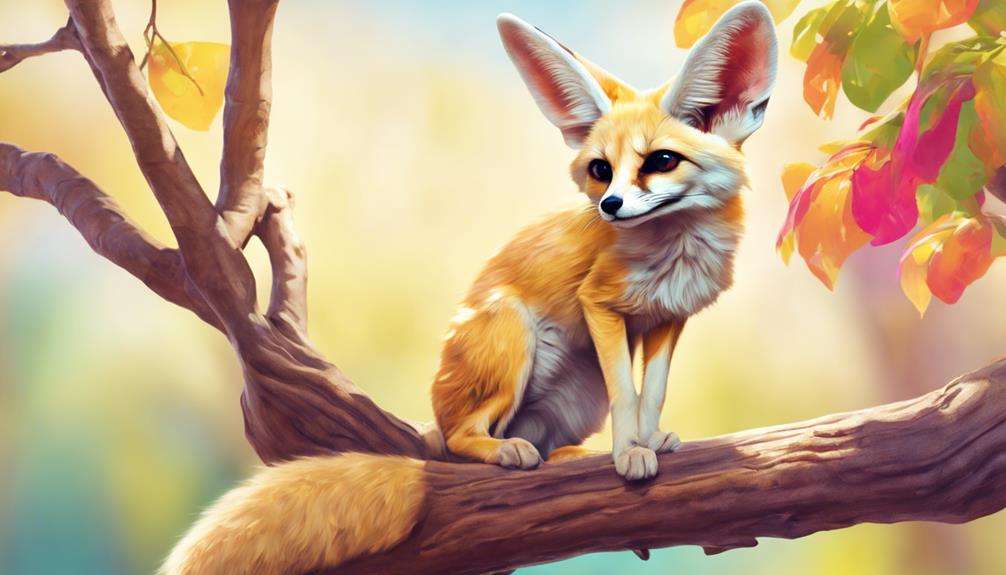
Fennec foxes possess unique physical features, such as their oversized ears that aid in heat regulation in desert environments.
Their diet and care require a delicate balance of insects, small mammals, and plants to meet their nutritional needs.
Legal considerations must be taken into account when considering these playful and curious creatures as exotic pets.
Unique Physical Features
With their oversized ears aiding in heat dissipation and pale fur for camouflage in sandy environments, the unique physical features of these diminutive foxes are truly remarkable.
Energetic behaviors are supported by their adaptations for survival in the harsh desert habitat. Fennec foxes' long tails provide balance and aid in communication within their social groups.
Weighing around 2-3 pounds on average, they're the smallest fox species, a characteristic that also contributes to their agility and speed. Their keen sense of hearing enables them to detect prey underground and communicate over long distances effectively.
Understanding these natural habitat insights sheds light on how these remarkable creatures have evolved to thrive in sandy landscapes, showcasing a perfect blend of form and function in the wild.
Diet and Care
In understanding the dietary requirements of fennec foxes, it's important to take into account their diverse natural diet and the necessary adjustments for captivity. Fennec foxes in the wild consume insects, small mammals, birds, fruits, and vegetation.
In captivity, a balanced diet includes high-quality commercial fox food, lean meats, and occasional fruits and vegetables. To prevent metabolic bone disease, calcium and vitamin D3 supplements are often essential. Monitoring food intake and providing enrichment activities are vital for preventing obesity and ensuring mental stimulation.
Understanding fennec fox dietary preferences is paramount for their health and well-being in captivity. By offering proper nutrition, enrichment, and care, you can help your fennec fox thrive both physically and mentally.
Legal Considerations
When considering the legal ownership of exotic pets like fennec foxes, it's essential to be aware of the specific permits or licenses required in your area. Fennec foxes are considered exotic pets, and ownership laws regarding them can vary greatly.
Some regions have strict permit regulations or outright prohibition on owning fennec foxes as pets due to their unique nature and specific care requirements. It's important to thoroughly research and understand the legal requirements and pet ownership restrictions associated with fennec foxes before bringing one into your home.
Illegal ownership or trafficking of these animals can result in severe legal consequences and pose risks to their well-being. To make sure compliance with fennec fox legality, consult local authorities or exotic pet experts for guidance.
Degus
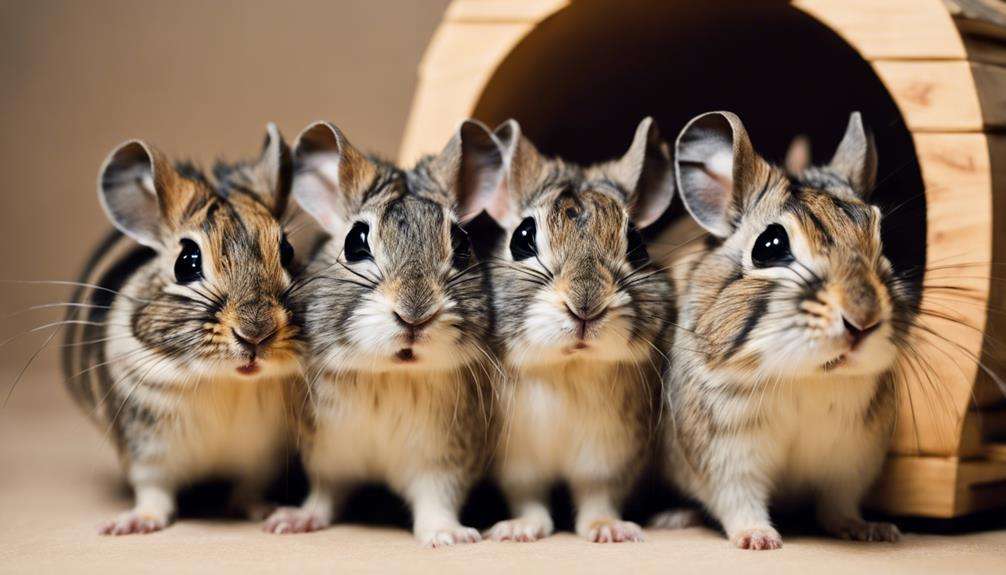
Native to Chile, the small and social rodents known as Degus exhibit an inquisitive and active nature. To guarantee their well-being, Degus require enrichment activities such as exercise wheels, tunnels, and chew toys to keep them mentally and physically stimulated.
Maintaining important dental health is vital for Degus, as their teeth continuously grow throughout their lives. Providing chew toys and hay is essential for them to grind down their teeth and prevent overgrowth.
When it comes to communication, Degus are vocal creatures, using a variety of sounds like chirps, barks, and drumming to interact with one another. Understanding their communication habits can help you interpret their needs and emotions accurately.
Remember to offer a balanced diet consisting of pellets, Timothy hay, and fresh vegetables to keep your Degus healthy and content. By providing a suitable environment and meeting their specific needs, Degus can thrive as engaging and delightful pocket pets.
Prairie Dogs
Prairie dogs exhibit fascinating behavior patterns within their intricate colonies. They communicate through a sophisticated system of vocalizations to ensure the group's safety and organization.
To properly care for these herbivorous rodents, attention to detail in replicating their natural habitat is essential for their well-being and health.
Understanding the nuances of prairie dog behavior and providing adequate care are vital for fostering a thriving and harmonious community of these social animals.
Prairie Dog Behavior
Living in intricate underground burrow systems known as 'towns,' prairie dogs exhibit highly social behaviors with complex communication networks. They communicate through a combination of vocalizations and body language, using various calls to convey messages about predators, food sources, and social interactions.
Prairie dogs also display dominance through behaviors like 'jump-yipping,' where they leap into the air while making vocalizations to establish rank within their social structure. Additionally, these fascinating creatures engage in greeting rituals, such as touching noses or grooming each other, to strengthen social bonds and maintain group cohesion.
Observing prairie dogs in their natural habitat offers a glimpse into their intricate social dynamics and the importance of communication in their daily lives.
Prairie Dog Care
To properly care for prairie dogs, make sure their diet consists mainly of grasses, seeds, and some insects, and maintain their intricate burrow systems with multiple entrances and chambers. These furry pocket pets thrive on a social structure within their colonies, communicating through a complex system of vocalizations and body language.
To guarantee their well-being, provide enrichment activities that mimic their natural habitat and encourage their natural behaviors. Understanding their communication cues and social hierarchy is critical for their mental stimulation and overall happiness. Regular veterinary care is essential to monitor their health and address any potential concerns promptly.
Additionally, keeping their burrows well-maintained is essential for their comfort and security, as these animals rely heavily on their underground homes for protection.
Jerboas
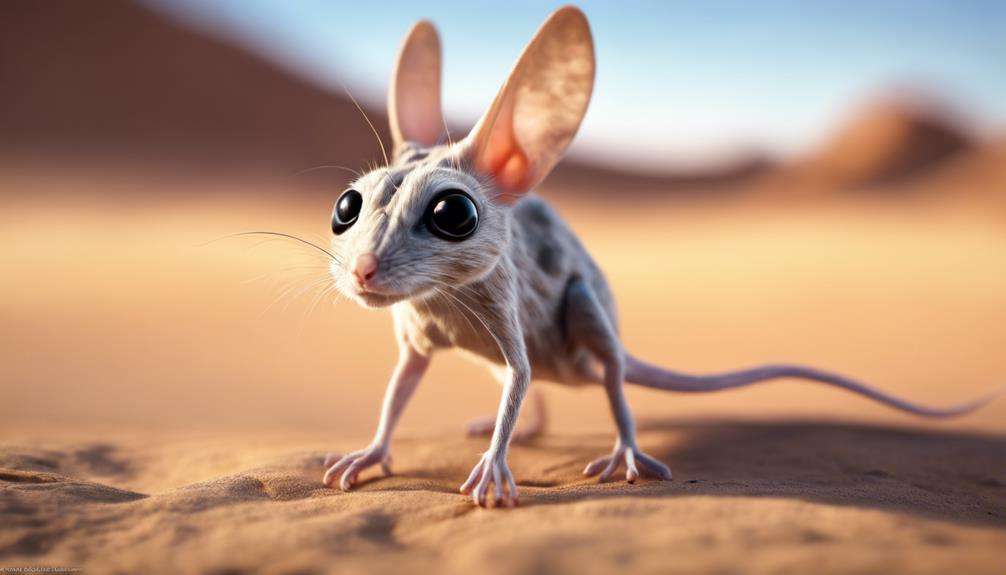
Jerboas, with their remarkable long hind legs enabling impressive jumps of up to 3 meters, are small desert-dwelling rodents found in North Africa and Asia. Their jumping abilities are vital for evading predators and moving around their arid habitats.
Nocturnal by nature, jerboas are most active during the night, using their keen senses to detect threats and find food. Their desert adaptation includes a unique diet comprising seeds, insects, and vegetation, allowing them to thrive in harsh environments where food sources may be scarce.
In the wild, jerboas have an average lifespan of 2-3 years, but in captivity, with proper care and attention, they can live longer. Their large ears not only aid in predator detection but also help regulate body temperature in the scorching desert climates they call home.
If considering a jerboa as a pet, ensure to provide a suitable environment that mimics their natural habitat and guarantees their well-being.
Kinkajous
The Kinkajou's unique characteristics make them fascinating nocturnal mammals native to Central and South America. These agile creatures exhibit nocturnal behavior, being most active during the night, which aligns with their arboreal lifestyle spent high in the forest canopy. One of their distinctive features is their prehensile tails, which are used as an extra limb to grasp branches tightly while they move with ease through the trees.
In the wild, Kinkajous have a diverse diet that includes fruits, nectar, insects, and occasionally small vertebrates. Despite their adorable appearance, they possess sharp teeth and claws that serve them well for climbing and self-defense. When kept in captivity, these honey bears require spacious enclosures that mimic their natural habitat, a varied diet to make sure their nutritional needs are met, and enrichment activities to keep them mentally and physically stimulated.
Considering their unique traits and care requirements, Kinkajous are truly intriguing creatures for those who are willing to provide them with the proper environment and attention.
Frequently Asked Questions
What Is the Best Pocket Pet to Have?
When choosing the best pocket pet for you, consider factors like size, lifespan, and care needs. Exotic rodents, tiny marsupials, and miniature rabbits each offer unique characteristics. Research thoroughly and seek advice from experts to find your perfect match.
What Is the Easiest Furry Pet to Take Care Of?
When it comes to furry pets, hamsters are your go-to choice for low maintenance companions. Their simple pet care routine and stress-free nature make them ideal for first-time owners looking for friendly and interactive furry friends.
What Is the Best Unique Pet to Have?
For unique pets, consider exotic options like sugar gliders, hedgehogs, or chinchillas. They make unusual companions with quirky alternatives to conventional pets. These creatures offer distinctive characteristics and care requirements that can provide a fascinating pet-owning experience.
What Animals Are Considered Pocket Pets?
Pocket pets, such as hamsters, guinea pigs, and mice, are considered tiny companions. These popular choices are low maintenance options that offer exotic options for pet owners. They are pocket-sized wonders known for being unconventional picks.
Conclusion
As you explore the world of fascinating furry pocket pets, remember the diversity of species available for companionship.
From the spiky Pygmy Hedgehogs to the agile Sugar Gliders, each creature offers a unique experience.
Embrace the curiosity of Chinchillas, the playfulness of Degus, and the charm of Wallabies.
Whether you choose a skunk, a prairie dog, or a kinkajou, the bond you form with these extraordinary animals will definitely be a rewarding adventure.
